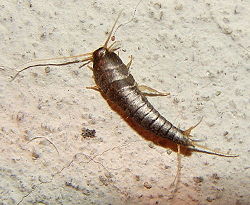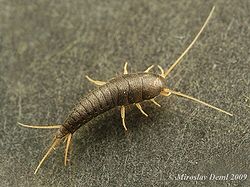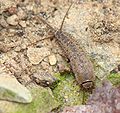Lepismatidae
| Lepismatidae |
|---|

|
| Scientific Classification |
|
| Genera |

|
| Silverfish (Lepisma saccharina) |
Lepismatidae is a taxonomic Family of insects composed mainly of its two members: the Silverfish and the Firebrats. The members of family are small insects that live in relatively warm conditions and often occupy basements and attics in houses. Although small, Silverfish and Firebrats can live from two to eight years. The body design is very simple and resembles the common traits of most insects. Some of the traits possessed are: an exoskeleton, antennae, and multiple pairs of walking legs. Their diet includes: glue, silk, cereal, and multiple other objects that are both edible and inedible.
Body Design
A silverfish has a silvery or brownish color because of the fine scales on its body. The only differences between silverfish and firebrats is the color and the habitat preference. The silverfish also has three long antennae-like objects coming out of its body as well as two very distinct, long antennae coming out of its head. A silverfish has a relatively long body resembling a tube-like shape and may grow as long as three-fourths of an inch long. In addition to these things, silverfish and firebrats are also completely wingless. Because the newborns of family Lepismatidae undergo incomplete metamorphosis, the youth resembles the adult versions, but is just smaller in size.[1] Near the head of the Silverfish, the body is bigger, but as it nears the back, it steadily decreases in size. Silverfish and Firebrats both have multiple pairs of legs used for locomotion. [2]
Life Cycle
Reproduction in Silverfish can occur in two possible ways. A male can fertilize the female directly or can perform a mating dance in which both sexes will participate. The male then leaves a package of sperm in which the female will take. [3] Like most members of class insecta, a silverfish starts its life cycle as an egg. The egg or eggs are deposited by an adult into a crack where the egg will stay until it hatches in about three weeks. Since silverfish have exoskeletons, they must periodically molt their shell in order to continue growing, which it will continue to do throughout its life. The length of time from egg-hood to adulthood is about four-to-six weeks. The members of family Lepismatidae undergo incomplete metamorphosis meaning they go through the stages of egg, nymph, and adult and also change colors from white to a more silver-like color as the egg becomes an adult. Although silverfish are only about one-twentieth of an inch when born, they will eventually grow to about one-fourth to even one-half of an inch before they die at about the age of two-to-eight years old.[1] Even though the members of family Lepismatidae relatively small, they are very quick runners for their size. They will run in short bursts, stop for a little bit, and then take off again.[2]
Ecology
The members of Lepismatidae try to avoid direct sunlight and are nocturnal(sleeps during the day and is awake and moving during the night)[2]. If the object a silverfish is hiding under is moved, the silverfish will run away and try to find somewhere else to hide instead. Silverfish live in dark, moist areas where the weather is relatively cool, making the United States an ideal living space. Ideally, a Silverfish will live in basements or bookcases where it is cool, dark, damp, and also relatively musty. Firebrats tend to live in dark, hot places like furnaces, bakeries, or heaters. They prefer environments at around 90 degrees or even hotter than that. For food, Silverfish eat carbohydrates and proteins. Some of the foods they eat are as follows: dried meat, oats, paper, and glue.[1] Because Silverfish and Firebrats are not picky eaters, they will eat almost anything and everything. Some of the unique items consumed by these insects are cotton, rayon, silk, and even linen. Once a place that will supply food has been obtained by a silverfish, it is more than likely that it will stay near it for a long time. Both species like to live in places where the humidity ranges from 75% to 95%. As well as being small, they are nuisances and also nocturnal. [2]
Differences between Silverfish and Firebrats
Although the two members of Lepismatidae are Silverfish and Firebrats, there is little distinction between them. Like Silverfish, Firebrats have almost the same dimensions, weight, size, and anatomy as Silverfish do. Some people ask why they are not considered one and the same and this is because of their distinction in color. While Silverfish resemble a silver color, the firebrats, however, have a more gray-like color and lack the silver color of its relative. [2] Therefore, Silverfish and Firebrats have their own distinction between them even though it may not be very apparent at first. Another difference between Silverfish and Firebrats is the living condition. While Silverfish prefer the relatively cool weather revolving around the sixties or seventies, the Firebrats prefer living in the hotter conditions of about ninety degrees or more.[4]
Control of Family Lepismatidae
Because of how common Silverfish and Firebrats are, they have become nuisances around the United States and other parts of the world also. Like many other insects and small pests, insecticides and pesticides have been created, tested, and used to control the population of Silverfish and Firebrats. There are two categories in which you can try to control the population of Silverfish and Firebrats. The two options you have for insect control in Lepismatidae are with or without chemicals. If you don't want to use chemicals for environmental purposes or other reasons, you can change the environment to make it unsuitable for the members of Lepismatidae, therefore, forcing them to move to another destination that further suits their preferred living condition. Also, you can seal cracks and crevices where Silverfish or Firebrats will try to hide or you can remove food supplies that the pests will use for a food source. If there is no food to eat, the insect will die or move to a more suitable place to live. The other existing option for control of Silverfish population is using pesticides or liquids to eliminate the insects. As far as liquids go, there are registered chemicals listed as follows: propoxur, chlorpyrifos, and bendiocarb. In some cases, the chemicals are more effective when mixed with pyrethrins. Pyrethrins irritate the insect which causes it to leave its living space and move more into the open. Chemicals should be sprayed into cracks and small spaces where Silverfish and Firebrats may be hiding. The last option for of control is called dusts. Dusts are more dangerous chemicals that are best used in places that are not commonly used by people or animals. [4] Some insecticides can also be dangerous to humans so instructions should be read and followed when attempting to use. [2] Furthermore, cleanliness will reduce the possibility of Silverfish and Firebrat infestation. Food and drinks should be cleaned as well as other items stored in plastic containers.[1]



